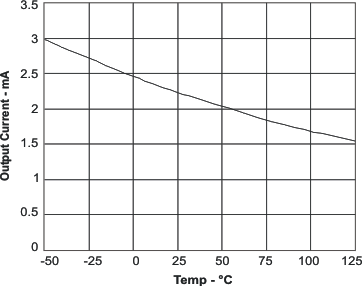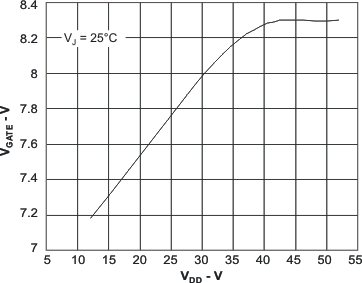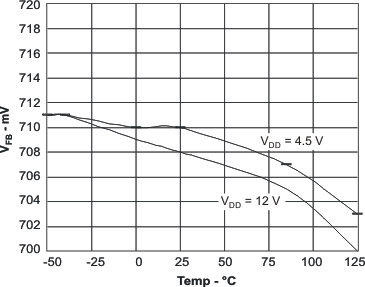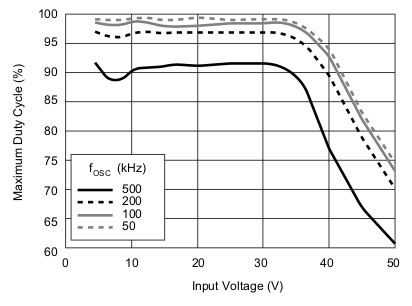SLUS739F September 2006 – January 2016 TPS40200-Q1
PRODUCTION DATA.
- 1 Features
- 2 Applications
- 3 Description
- 4 Revision History
- 5 Pin Configuration and Functions
- 6 Specifications
- 7 Detailed Description
-
8 Application and Implementation
- 8.1 Application Information
- 8.2
Typical Applications
- 8.2.1
Buck Regulator, 8-V to 12-V Input, 3.3-V or 5-V Output at 2.5 A
- 8.2.1.1 Design Requirements
- 8.2.1.2 Detailed Design Procedure
- 8.2.1.3 Application Curves
- 8.2.2 Application 2: 18-V to 50-V Input, 16-V Output at 1 A
- 8.2.3 Application 3: Wide-Input-Voltage LED Constant-Current Driver
- 8.2.1
Buck Regulator, 8-V to 12-V Input, 3.3-V or 5-V Output at 2.5 A
- 9 Power Supply Recommendations
- 10Layout
- 11Device and Documentation Support
- 12Mechanical, Packaging, and Orderable Information
Package Options
Mechanical Data (Package|Pins)
- D|8
Thermal pad, mechanical data (Package|Pins)
Orderable Information
6 Specifications
6.1 Absolute Maximum Ratings
over operating free-air temperature range (unless otherwise noted) (1)(1) Stresses beyond those listed under Absolute Maximum Ratings may cause permanent damage to the device. These are stress ratings only, which do not imply functional operation of the device at these or any other conditions beyond those indicated under Recommended Operating Conditions. Exposure to absolute-maximum-rated conditions for extended periods may affect device reliability.
6.2 ESD Ratings
| VALUE | UNIT | |||
|---|---|---|---|---|
| V(ESD) | Electrostatic discharge | Human-body model (HBM), per AEC Q100-002(1) | ±1000 | V |
| Charged-device model (CDM), per AEC Q100-011 | ±1500 | |||
| Machine model (MM) | ±100 | |||
(1) AEC Q100-002 indicates that HBM stressing shall be in accordance with the ANSI/ESDA/JEDEC JS-001 specification.
6.3 Recommended Operating Conditions
| MIN | MAX | UNIT | ||
|---|---|---|---|---|
| VDD | Input voltage | 4.5 | 52 | V |
| TA | Operating temperature | –40 | 125 | °C |
6.4 Thermal Information
over operating free-air temperature range (unless otherwise noted)| THERMAL METRIC(1) | TPS40200-Q1 | UNIT | |
|---|---|---|---|
| D (SOIC) | |||
| 8 PINS | |||
| RθJA | Junction-to-ambient thermal resistance | 115.7 | °C/W |
| RθJC(top) | Junction-to-case (top) thermal resistance | 64.2 | °C/W |
| RθJB | Junction-to-board thermal resistance | 56 | °C/W |
| ψJT | Junction-to-top characterization parameter | 17.7 | °C/W |
| ψJB | Junction-to-board characterization parameter | 55.5 | °C/W |
(1) For more information about traditional and new thermal metrics, see the Semiconductor and IC Package Thermal Metrics application report, SPRA953.
6.5 Electrical Characteristics
–40°C < TA < 125°C, VDD = 12 V, fOSC = 100 kHz (unless otherwise noted)| PARAMETER | TEST CONDITIONS | MIN | TYP | MAX | UNIT | ||
|---|---|---|---|---|---|---|---|
| VOLTAGE REFERENCE | |||||||
| VFB | Feedback voltage | COMP = FB , 4.5 V < VDD < 52 V, –40°C < TA < 125°C | 676 | 696 | 712 | mV | |
| GATE DRIVER | |||||||
| Isrc | Gate driver pullup current | 125 | 300 | mA | |||
| Isnk | Gate driver pulldown current | 200 | 300 | mA | |||
| VGATE | Gate driver output voltage | VGATE = (VDD – VGDRV), 12 V < VDD < 52 V | 5.6 | 8 | 10 | V | |
| QUIESCENT CURRENT | |||||||
| Iqq | Device quiescent current | fOSC = 300 kHz, Driver not switching, 4.5 V < VDD < 52 V | 1.5 | 3 | mA | ||
| UNDERVOLTAGE LOCKOUT (UVLO) | |||||||
| VUVLO(on) | Turn-on threshold | –40°C < TA < 125°C | 3.8 | 4.25 | 4.55 | V | |
| VUVLO(off) | Turn-off threshold | 4.05 | V | ||||
| VUVLO(HYST) | Hysteresis | 110 | 200 | 275 | mV | ||
| SOFT START | |||||||
| RSS(chg) | Internal soft-start pullup resistance | 65 | 105 | 170 | kΩ | ||
| RSS(dchg) | Internal soft-start pulldown resistance | 190 | 305 | 485 | kΩ | ||
| VSSRST | Soft-start reset threshold | 100 | 150 | 200 | mV | ||
| OVERCURRENT PROTECTION | |||||||
| VILIM | Overcurrent threshold | 4.5 V < VDD < 52 V, –40°C < TA < 125°C | 50 | 100 | 140 | mV | |
| OCDF | Overcurrent duty cycle(1) | 2% | |||||
| VILIM(rst) | Overcurrent reset threshold | 100 | 150 | 200 | mV | ||
| OSCILLATOR | |||||||
| fOSC | Oscillator frequency range(1) | 35 | 500 | kHz | |||
| Oscillator frequency | RRC = 200 kΩ, CRC = 470 pF | 85 | 100 | 118 | kHz | ||
| RRC = 68.1 kΩ, CRC = 470 pF | 210 | 300 | 345 | ||||
| Frequency line regulation | 12 V < VDD < 52 V | –9% | 0% | ||||
| 4.5 V < VDD < 12 V | –21% | 0% | |||||
| VRMP | Ramp amplitude | 4.5 V < VDD < 52 V | VDD / 10 | V | |||
| PULSE-WIDTH MODULATOR | |||||||
| tMIN | Minimum controllable pulse width (2) | VDD = 12 V | 200 | 540 | ns | ||
| VDD = 30 V | 100 | 200 | |||||
| DMAX | Maximum duty cycle | Fosc = 100 kHz, CL = 470 pF | 93% | 95% | |||
| Fosc = 300 kHz, CL = 470 pF | 90% | 93% | |||||
| KPWM | Modulator and power-stage DC gain | 8 | 10 | 12 | V/V | ||
| ERROR AMPLIFIER | |||||||
| IIB | Input bias current | 100 | 250 | nA | |||
| AOL | Open loop gain(1) | 60 | 80 | dB | |||
| GBWP | Unity gain bandwidth(1) | 1.5 | 3 | MHz | |||
| ICOMP(src) | Output source current | VFB = 0.6 V, COMP = 1 V | 100 | 250 | μA | ||
| ICOMP(snk) | Output sink current | VFB = 1.2 V, COMP = 1 V | 1 | 2.5 | mA | ||
(1) Specified by design
(2) See Figure 21 for typical tMIN vs fOSC at various input voltages.
6.6 Typical Characteristics
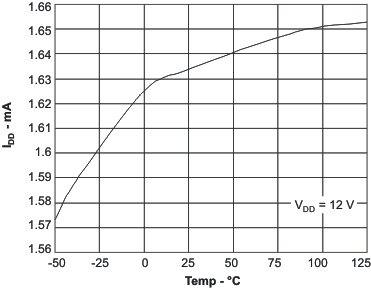
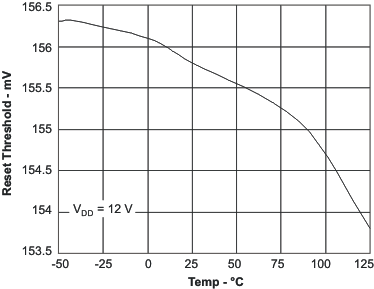
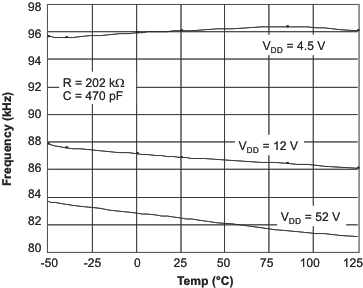
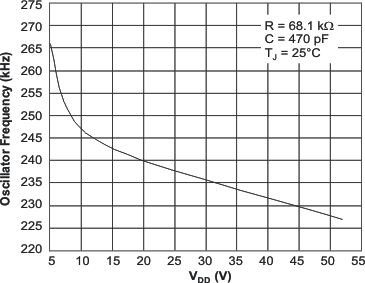
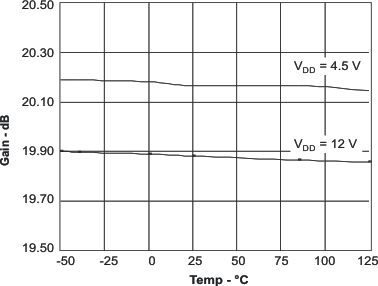
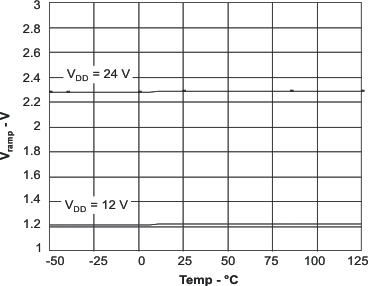
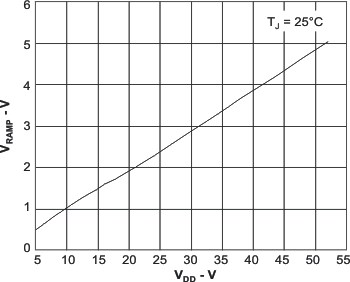
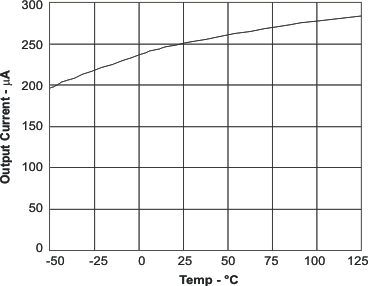
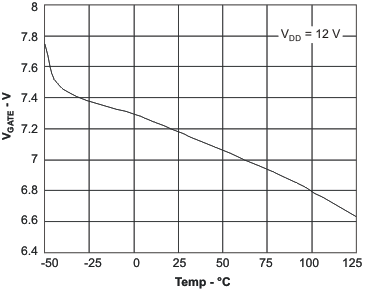
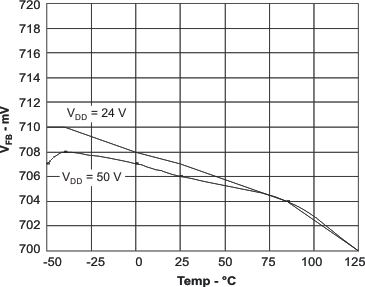
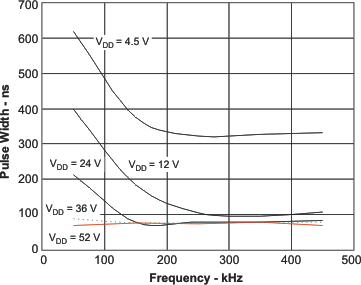
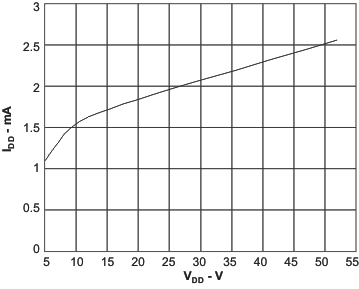
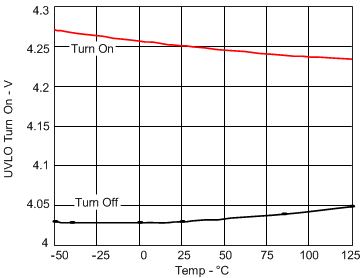
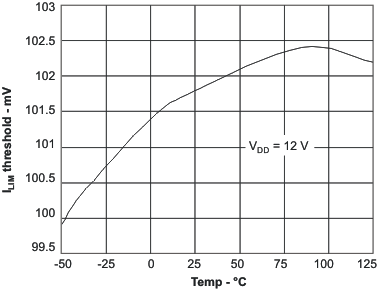
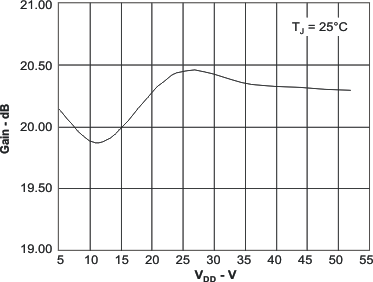
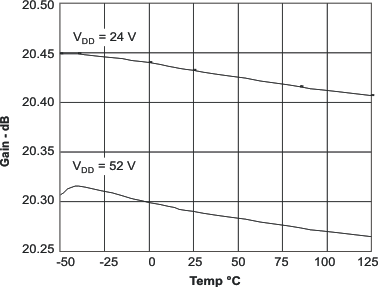
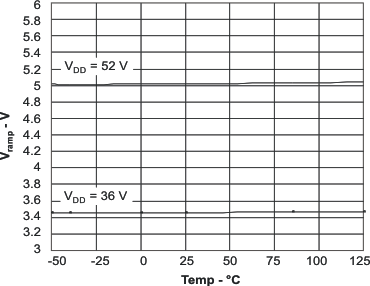
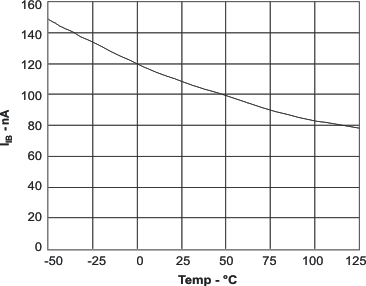
vs Temperature
